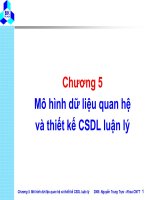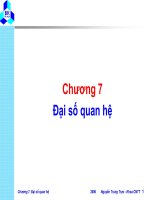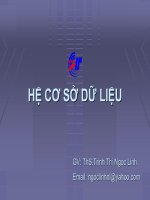BAI GIANG HE CO XUONG (musculoskeletal system)
Bạn đang xem bản rút gọn của tài liệu. Xem và tải ngay bản đầy đủ của tài liệu tại đây (1.53 MB, 52 trang )
Locomotor/Musculoskeletal system
(Hệ vận động- Sinh lý cơ và xương)
In this chapter, students will learn:
•Components of the musculoskeletal system
•Basic of how musculoskeletal system generates motion
•Structure of skeletal muscle: muscle fiber, myofibrils, actin and myosin filaments
• Structures of a sarcomere
•The movements of actin and myosin filaments during muscle contraction
•Molecular mechanism of muscle contraction. The crossbridge cycle. Role of
Ca2+ and ATP in muscle contraction
•Motor unit
•muscle twitch and phases of a muscle twitch
•Isotonic and isometric contraction
•muscle fatigue
•ATP production in muscle cells – Oxygen debt
•Structure of bone tissue, bone cells and their function
•Osteoblast, osteocyte, osteoclast and their function
• long bone elongation and bone remodeling
• Structure of smooth muscle and molecular mechanism of smooth muscle
contraction
Specific terms and keywords
• Muscle
– Muscular system
– Musculature
– Neuromuscular junction
– Muscle force/tension
– Crossbridge
– Sarcomere
– thin and thick filaments
• Skeleton
– Skeletal system
– Musculoskeletal system
– Osteoblast
– Osteoclast
– Bone modeling/remodeling
– Mineralization/calcification
Musculoskeletal system
Cơ nhị đầu (giãn)
Cơ tam đầu (co)
•
•
•
•
•
•
muscles
bones (the skeleton)
cartilage
tendons, ligaments
joints
other connective tissue
/>
Muscles and skeletal are main components of locomotor system
– striated/skeletal muscle
exoskeletal
– soft-bodied animals
– smooth muscle
– cardiac muscle
endoskeletal,
Hydrostatic skeletal/
hydroskeletal: fluid-filled
cavity surrounded by
muscles
The musculoskeletal system generates motion for
animals
• Muscles are attached to bones
• Bones are connected by joints
• Muscle contraction allows motion of the bone attached at
the joints
• Muscles across joints are arranged in antagonistic
groups allowing motion in different directions
Skeletal muscle – structure and physiology
Structure of a skelelal muscle
xương
gân
Bắp cơ
Mô liên kết
Bó cơ
Sợi cơ
Tơ cơ
Màng sợi cơ
Các sợi cơ
trong bó cơ
•
Các sợi protein
Nhân
Muscle body
– fascicle
• muscle fibers – muscle cell surrounded by sarcolemma: multiple nuclei Cơ tương (chứa
myoglobin), myofibrils, protein filaments
C.L. Standfield.2011. Principles of Human Physiology, 4th edition.
Structure of a muscle cell
Khớp nối thần kinh cơ
Túi synap
Axon của TB thần
kinh vận động
Khe synap
Sợi cơ
Tận cùng vận động
ống T
nhân
Màng bao cơ
Lưới cơ tương
Lưới cơ tương
ống T
Tơ cơ
Ti thể
Sợi dày
(myosin)
Fig. 12.2 C.L. Standfield.2011. Principles of Human Physiology, 4 th edition.
Sợi mỏng
(actin)
Myofibril and sarcomere
Đĩa A
Vạch Z
Đĩa I
Vạch M
Sợi dày
•
Sợi mỏng
•
•
•
Fig. 12.2 C.L. Standfield.2011. Principles of Human Physiology, 4th edition.
Thick and thin
filaments are
orderly arranged (in
a 1:2 ratio) showing
striped appearance
(hence the name
striated muscle)
Z line
M line
Sarcomere (Đơn vị co
cơ): the structure
between two
neighbouring z lines
Structure of a sarcomere
Sarcomere
A band ( dark band)
Z-line
I band
(light band) myosin
H zone
actin
•A band ( dark band): thick
filaments overlapped with
thin filaments at the two
ends
•H zone: center region of A
band where only thick
filaments are present
I band
(light band)
www.arn.org/docs/glicksman/eyw_040901.htm
• I band: structure between A
bands where only thin
filaments are present
Structure of a thick filament
• thick filament myosin:
– A myosin molecule is a dimer
composed of two subunits
wound together making a “golf
stick” shape:
+ Actin-binding site
+ ATPase site
Fig. 12.5 C.L. Standfield.2011. Principles of Human Physiology, 4th edition.
Structure of a thin filament
• Thin filament:
–
–
–
–
G actin: monomer containing myosinbinding site
F actin: a strand of G-actin
2 F actins are arranged in double helix
forming actin strands found in thin
filaments
2 regulatory proteins control the
contraction of muslce fiber
• Tropomyosin: long fibrous molecule
extending over actin monomers to
block the myosin-binding site when
muslce is at rest.
• Troponin complex consists of 3
subunites:
– One attaches to the actin strand
– One binds tropomyosin
– One is the site for reversible
binding with Ca2+
Fig. 12.5 C.L. Standfield.2011. Principles of Human Physiology, 4th edition.
Sliding -filament model of muscle contraction
Muscle relaxed : H zone is increased in length
Muscle contracted : H zone is decreased in length
Fig. 12.5 C.L. Standfield.2011. Principles of Human Physiology, 4th edition.
Molecular mechanism of muscle contraction: overview
•
•
•
•
Fig. 12.8 C.L. Standfield.2011. Principles of Human Physiology, 4 th edition.
7 steps
T- Tubules (transverse
tubules): membranous tubules
formed by deep invagination of
sarcolemma into the cytoplasm
of the muscle cell
T- tubules transmit action
potential
High Ca2+ concentration in
lumen of the SR (sarcoplasmic
reticulum) when muscle relaxed
Molecular mechanism of muscle contraction, step 1:
acetylcholine release and the generation of action potential in
the motor end plate of neuromuscular junction
• Neuromuscular junction:
- presynaptic motor neuron
(synaptic vesicles containing
Acetylcholine-ACh)
- postsynaptic muscle cell
membrane –motor end plate
(ACh receptors)
- ACh-gated Na+ channels on
motor end plate
- Acetylcholinesterase
/>
Molecular mechanism of muscle contraction, step 2-3:
action potential propagates down T-tubules triggering
Ca2+ release from sarcoplasmic reticulum
• Voltage-sensitive DHP
receptor in T tubules
• Ryanodine receptors in the
SR membrane associate
with calcium channels
• AP -> DHP receptor-> open
Ca2+ channels-> Ca2+
release from SR to the
cytosol
C.L. Standfield.2011. Principles of Human Physiology, 4th edition.
Molecular mechanism of muscle contraction, step 4:
how Ca2+ function in muscle contraction
C.L. Standfield.2011. Principles of Human Physiology, 4th edition.
Molecular mechanism of muscle contraction, step 4:
the crossbridge cycle
• Ca 2+
•
C.L. Standfield.2011. Principles of Human Physiology, 4th edition.
ATP
Step 6-7: muscle fiber relaxes after crossbridge cycles
Fig. 12.8 C.L. Standfield.2011. Principles of Human Physiology, 4 th edition.
Rigor mortis (Sự cứng cơ khi chết)
– No more ATP production
– Ca 2+ are still available in the cytosol
Neurotoxins and muscle paralysis
• Spastic paralysis
stiffness of
the muscles and muscular
spasms
(Liệt co cứng ):
+ insecticides,
chemical weapons
inhibit AChE
• Flaccid paralysis
(Liệt mềm nhũn ): a
weakness
or lack of muscle tone
+ Snake venom
+ Curare
+ Botulinum (Clostridium
botulinum)- botulism
/>
•
Botox
Questions
Regarding muscle contraction process,
What would happen if:
1. Na+ ion channels were blocked and there was no movement of Na+
through membrane of muscle cells ?
2. There was an insufficient amount of ATP available in the muscle cells ?
3. There were an sufficient amount of ATP and an excess amount of
Ca2+ available in the cytosol of muscle fibers ?
Muscle twitch and its phases
• A twitch is the mechanical
response of an individual muscle
cell, a motor unit, or a whole
muscle to a single action potential
– Lag/latent peroid (Giai đoạn tiềm tàng ):
2ms: delay time between the action
potential in the muscle cell and the
start of contraction ( release of Ca 2+ )
– contraction phase (Giai đoạn cơ co): 10100 ms: time between the end of
latent period and the peak of muscular
tension: increasing cytosolic Ca2+
levels, increasing active actin-myosin
crossbridges
– relaxation phase (Giai đoạn cơ giãn):
decreasing cytosolic Ca2+ levels,
decreasing active actin-myosin
crossbridges
C.L. Standfield.2011. Principles of Human Physiology, 4th edition.
• Muscle tension/ muscle force is
measured in unit of mass (gram
(g)
Motor unit (Đơn vị vận động)
• Motor unit :
– A motor neuron
and all the
muscle fibers
innervated by
that neuron are
collectively
defined as a
motor unit
/>
Isometric and isotonic contraction
• isometric contraction (Co cơ đẳng trường):
- Tension created, but muscle does not
shorten as the load is greater than the
force generated
– Unchanged muscle length
Co cơ đẳng trường
• isotonic contraction (Co cơ đẳng trương):
– Created tension is equal or greater
than the load
– The muscle shortens, muscle length
changes
Co cơ đẳng trương
Fig. 12.13 C.L. Standfield.2011. Principles of Human Physiology,









